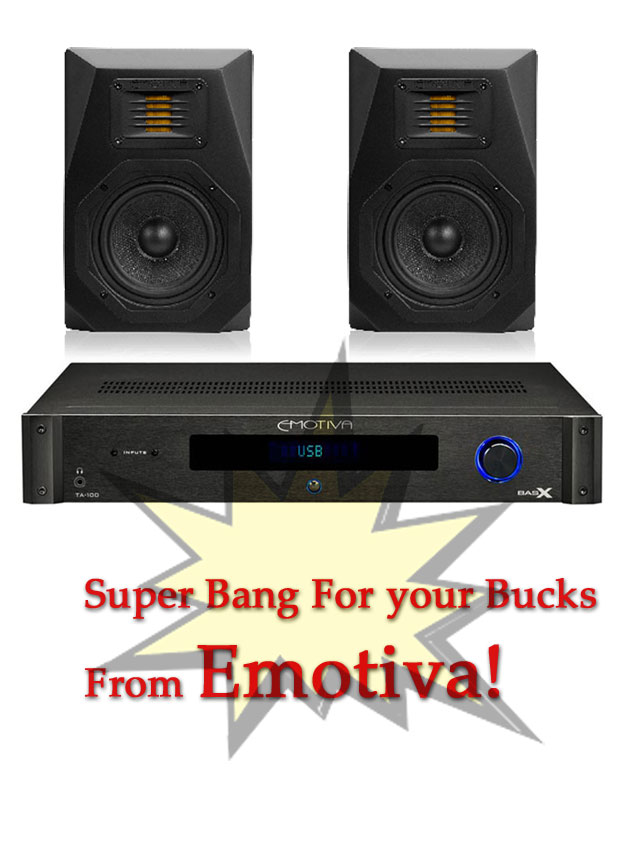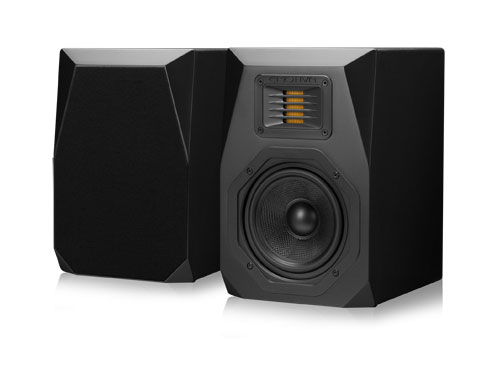Emotiva BasX TA-100 Integrated and Airmotiv B1 Loudspeakers

 Emotiva was originally founded by Dan Laufman in the mid ’90s. Frustrated by the trend in the HIFI industry toward “audio unobtanium,” Emotiva was born on the premise that audio can sound great and be something ordinary working people can actually afford.
Emotiva was originally founded by Dan Laufman in the mid ’90s. Frustrated by the trend in the HIFI industry toward “audio unobtanium,” Emotiva was born on the premise that audio can sound great and be something ordinary working people can actually afford.
Both the Emotiva BasX TA-100 Integrated Amp/DAC/Tuner and the Airmotiv B1 Bookshelf Loudspeakers have an all-black satin finish, which in my opinion is a clean and classy look. The brushed aluminum on the TA-100 has a premium feel. The display of the TA-100 is legible and works perfectly, both by hand or paired with the remote control. I feel everything about the display and set up of this system is sturdy and intuitive, and I had no trouble getting things up and running.

The TA-100 will satisfy audiophiles who want everything wired. The 2-channel receiver provides two pairs of Analog inputs, one for CD, and one for Aux. There’s also one pair of switchable phono inputs, which can transition between a moving magnet or moving coil set-up.
The TA-100 is similar to the Onkyo TX-8050 receiver, my reference unit, which was released in 2011. Both have an FM radio with an external antenna input. The TA-100 has memory functions that can store up to 50 FM stations. My Onkyo can hold up to 40 FM stations. The TA-100 has a respectable amount of outputs. There’s one pair of main line level outputs for unbalanced stereo listening, one pair of speaker outputs for stereo listening which have a 5-way binding post, two full range outputs which allow users to connect one or two subwoofers, and one stereo headphone output on the front panel.
The TA-100 also has plenty of digital inputs. There’s one coax (S/PDIF) and digital optical (Toslink) which support 24-bit/192 kHz playback. The digital USB DAC input supports 24-bit/96 kHz playback. Unfortunately, the TA-100 doesn’t support 24-bit/192 kHz audio, a common standard for most of the hi-res albums in my music collection, which I’ve downloaded from HDTracks.com (hdtracks.com). The newish Sony STR-DN1080 7.2 channel ($600, at sony.com) and the Onkyo TX-NR656 7.2 channel ($449 at Amazon.com) can playback hi-res albums at higher specifications and offer a wide-range of WIFI streaming services. The TX-8050 supports HD Radio and streaming of FLAC files from your laptop or desktop with the UWF-1 Wireless USB Network Adapter over 2.4 GHz WIFI. The TA-100 doesn’t support HD Radio, which many cars have, or WIFI streaming. The omission of HD Radio is forgivable but the lack of WIFI streaming is unacceptable in an era when the inexpensive Google Home speaker ($130 at google.com) supports iHeart Radio, Spotify, YouTube Music, Google Play Music, Tunein, and Pandora. The work-around is to use Emotiva’s optional Bluetooth Dongle, the BTM-1, which supports Apt X streaming and beam music from apps on your tablet to the receiver over Bluetooth.

Since most speakers need a period of settling in, I decided initially to play a variety of different types of music, often jumping around from genre to genre. I played them moderately loud for several hours a day over the course of a few days, but always as background music while I did other things around the house. I did this purposefully so that I could notice first impressions, but could not accidentally listen too closely and pass judgment on the system while I knew the Airmotiv B1’s were still settling in. I’ll mention some of my first impressions here so that I can compare what I initially heard to what I heard after the speakers acclimated. Once I got the placement correct, I right away noticed that the speakers give a good sense of space. For this reason, instrumental separation sounded quite good. They were relatively clear throughout, but noticeably bright in the middle and upper registers. For instance, not only did they heighten the upper partials of percussion instruments like xylophone and cymbals, but also, they did the same with the, usually, mellow timbre of Thom York’s voice. After a few days however, the brightness did settle, and when I felt I had sufficiently opened up the Airmotiv B1’s, I sat down to really listen to Brahms’ Symphony No. 1, performed by the iconic Berlin Philharmonic with Simon Rattle conducting. I was particularly interested in listening to Brahms on this system because I wanted to hear how the Airmotiv B1 speakers and amp would handle the extreme density of texture, and richness of sound for which Brahms is so famous. I listened to this recording through the Naxos Music Library to ensure I was hearing the best quality I could find online, and I signed into Naxos via my iPhone so that I could also test the Bluetooth capabilities of the system.
 The fourth movement of Brahms’ Symphony No. 1 begins with an extended transition that among other things, alternates in the strings between melancholy, linear lines and forward moving pizzicato. The whole opening becomes more and more frenetic until the orchestra falls off a cliff, so to speak. What emerges from the dust is a soaring French horn solo, famously challenging for the player and cathartic for the listener. Here in the horn’s melody, the timbral quality was well balanced with the orchestral accompaniment, but I did feel I wanted to hear more full body out of the horn. However, when the flute plays in response to the horn, it’s mid to high registers really spoke with an excellent balance of clarity and resonance. It was not too bright at all. At the entrance of the angelic trombone choir, I felt again that the Emotiva system performed best in the mid and upper registers, and were somewhat lackluster on the lower end. Because of this, I was curious to make some alterations to the bass trim and try again on this excerpt. However, I couldn’t stop the music just yet – I was finally about to hear what everything had been leading to. When the strings enter again, Brahms finally reveals his response to Beethoven’s Ninth Symphony. The rich string melody, an allusion to Beethoven’s Ode to Joy, is set in an ideal register for the Airmotiv B1 loudspeakers. They were able to pull out a depth and fullness in the mid-range string sound – a quality so needed at this moment of musical reveal. As Brahms begins to manipulate this melody, the texture gets thicker and more instruments join in. Here particularly, I wanted more clarity in timpani – yet another instance of the bass register needing both more fullness and crispness. I finally decided to stop and boost the bass, using the very intuitive and well designed remote control. I tried again from the beginning of the movement, and truly, this minor adjustment made all the difference. Right from the opening of the last movement, the timpani had the fullness that I wanted, the horn solo and trombone choir had added depth, and the bass pizzicato resonated and rang. This was exactly what I had been yearning for and the Emotiva system totally delivered.
The fourth movement of Brahms’ Symphony No. 1 begins with an extended transition that among other things, alternates in the strings between melancholy, linear lines and forward moving pizzicato. The whole opening becomes more and more frenetic until the orchestra falls off a cliff, so to speak. What emerges from the dust is a soaring French horn solo, famously challenging for the player and cathartic for the listener. Here in the horn’s melody, the timbral quality was well balanced with the orchestral accompaniment, but I did feel I wanted to hear more full body out of the horn. However, when the flute plays in response to the horn, it’s mid to high registers really spoke with an excellent balance of clarity and resonance. It was not too bright at all. At the entrance of the angelic trombone choir, I felt again that the Emotiva system performed best in the mid and upper registers, and were somewhat lackluster on the lower end. Because of this, I was curious to make some alterations to the bass trim and try again on this excerpt. However, I couldn’t stop the music just yet – I was finally about to hear what everything had been leading to. When the strings enter again, Brahms finally reveals his response to Beethoven’s Ninth Symphony. The rich string melody, an allusion to Beethoven’s Ode to Joy, is set in an ideal register for the Airmotiv B1 loudspeakers. They were able to pull out a depth and fullness in the mid-range string sound – a quality so needed at this moment of musical reveal. As Brahms begins to manipulate this melody, the texture gets thicker and more instruments join in. Here particularly, I wanted more clarity in timpani – yet another instance of the bass register needing both more fullness and crispness. I finally decided to stop and boost the bass, using the very intuitive and well designed remote control. I tried again from the beginning of the movement, and truly, this minor adjustment made all the difference. Right from the opening of the last movement, the timpani had the fullness that I wanted, the horn solo and trombone choir had added depth, and the bass pizzicato resonated and rang. This was exactly what I had been yearning for and the Emotiva system totally delivered.
 I kept the Airmotiv B1 loudspeakers set with the previous adjustment and listened next to several tunes from “The Bad Plus’” 2012 album, Made Possible. The wistful tune, Pound for Pound, whose simple and spacious opening played on drum kit and piano, was the perfect choice to highlight the best qualities of the Emotiva system. This track is all about space, breath, and intimacy. Especially at the beginning when time seems to feel stretched, the speakers did a wonderful job giving a sense of instrumental separation and space. Occasionally in the pockets of breath, the bass’ pizzicato will come to the fore. In these moments, the Airmotiv B1 loudspeakers balanced this new timbre very evenly and I believe, because of the bass trim, they did so with a much more natural sense of fullness. I wasn’t wanting for anything different out of the Emotiva system on this track.
I kept the Airmotiv B1 loudspeakers set with the previous adjustment and listened next to several tunes from “The Bad Plus’” 2012 album, Made Possible. The wistful tune, Pound for Pound, whose simple and spacious opening played on drum kit and piano, was the perfect choice to highlight the best qualities of the Emotiva system. This track is all about space, breath, and intimacy. Especially at the beginning when time seems to feel stretched, the speakers did a wonderful job giving a sense of instrumental separation and space. Occasionally in the pockets of breath, the bass’ pizzicato will come to the fore. In these moments, the Airmotiv B1 loudspeakers balanced this new timbre very evenly and I believe, because of the bass trim, they did so with a much more natural sense of fullness. I wasn’t wanting for anything different out of the Emotiva system on this track.
The second song on the album, Seven Minute Mind, begins with a linear and hypnotic piano line, upon which more and more layers are slowly overlaid. Taking elements from a theme and variations structure, this repeating line, as well as several other layers, are passed around almost continuously throughout the whole track, while new ideas are presented above them. As a whole, what emerges is a tune with many different moods, textures, and timbral combinations. In the denser sections, what is most noticeable with the Emotiva system was the even balance between registers. In the sparser sections, the sense of space that these seemingly modest loudspeakers produce, made me feel as though The Bad Plus was performing a house concert in my own living room!
Overall, I can heartily recommend the Emotiva BasX TA-100 Integrated Amp/DAC/Tuner with the Airmotiv B1 Bookshelf loudspeakers as a wonderful entry level system for people wanting a hi-res home audio system as a reasonable price. The Bluetooth worked flawlessly in all my trials, and I believe that the TA-100 has enough power and flexibility in terms of adjustment, that it should work well with all genres.
Emotiva’s response: Thanks to Mark Abel and Stereo Times for a great review. We appreciate the good word, but I’d like to address a couple comments made in the piece.
As I’m sure you know, the vast majority of high end gear does not include streaming audio, let alone a sub-$400 integrated amp that is already packed with a built in DAC, MC/MM phono stage, tuner, fully discrete output stage with a toroidal power supply, a solid 12MM billet aluminum faceplate… you get the idea.
The reason we didn’t include 24/192 support on USB was to ensure that we aren’t opening the door to potential issues with driver installation. Also, you have to consider that music lovers buying an all-in-one $399.00 integrated amp are rarely listing to 192k audio files from HD tracks. Our goal was to design an integrated amp that delivers outstanding sonics, flexibility, and ease of use for anybody who wants to enjoy their favorite music on a high-end system at a real-world affordable price.

mark abell
Specifications:
Emotiva BasX TA-100 Integrated Amp/DAC/Tuner
Price: $399.00
Specs: https://emotiva.com/product/ta-100/
Emotiva Airmotiv B1 Bookshelf loudspeaker
Price: $299.00
Stereo Times Masthead
Publisher/Founder
Clement Perry
Editor
Dave Thomas
Senior Editors
Frank Alles, Mike Girardi, Russell Lichter, Terry London, Moreno Mitchell, Paul Szabady, Bill Wells, Mike Wright, and Stephen Yan,
Current Contributors
David Abramson, Tim Barrall, Dave Allison, Ron Cook, Lewis Dardick, John Hoffman, Dan Secula, Don Shaulis, Greg Simmons, Eric Teh, Greg Voth, Richard Willie, Ed Van Winkle, Rob Dockery, Richard Doron, and Daveed Turek
Site Management Clement Perry
Ad Designer: Martin Perry





Be the first to comment on: Emotiva BasX TA-100 Integrated and Airmotiv B1 Loudspeakers